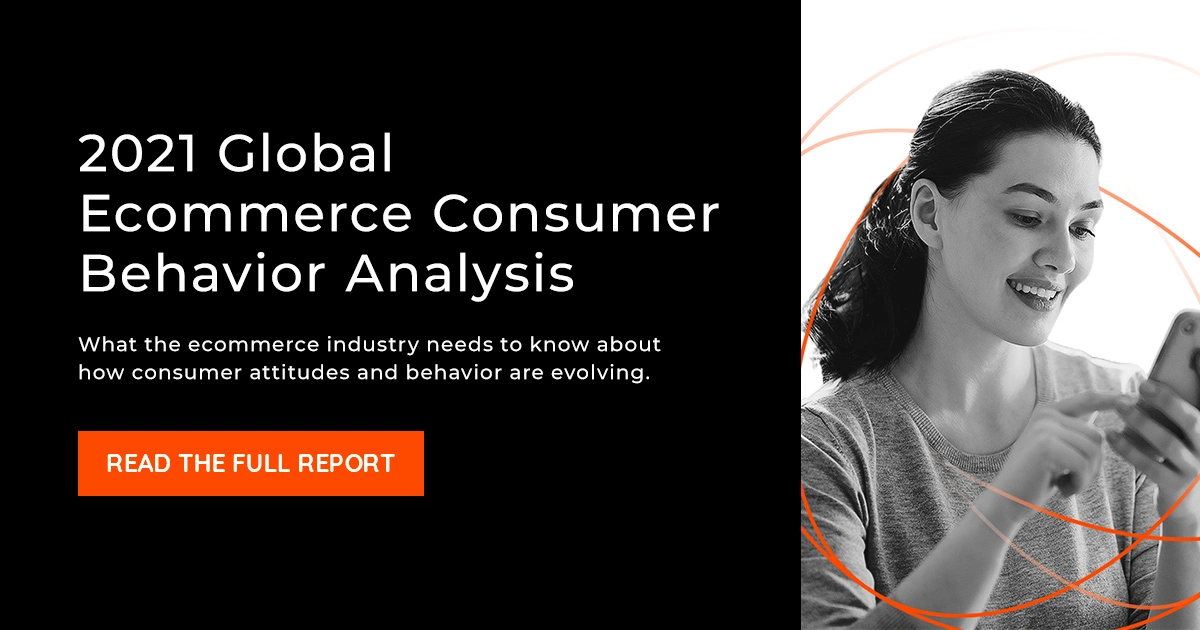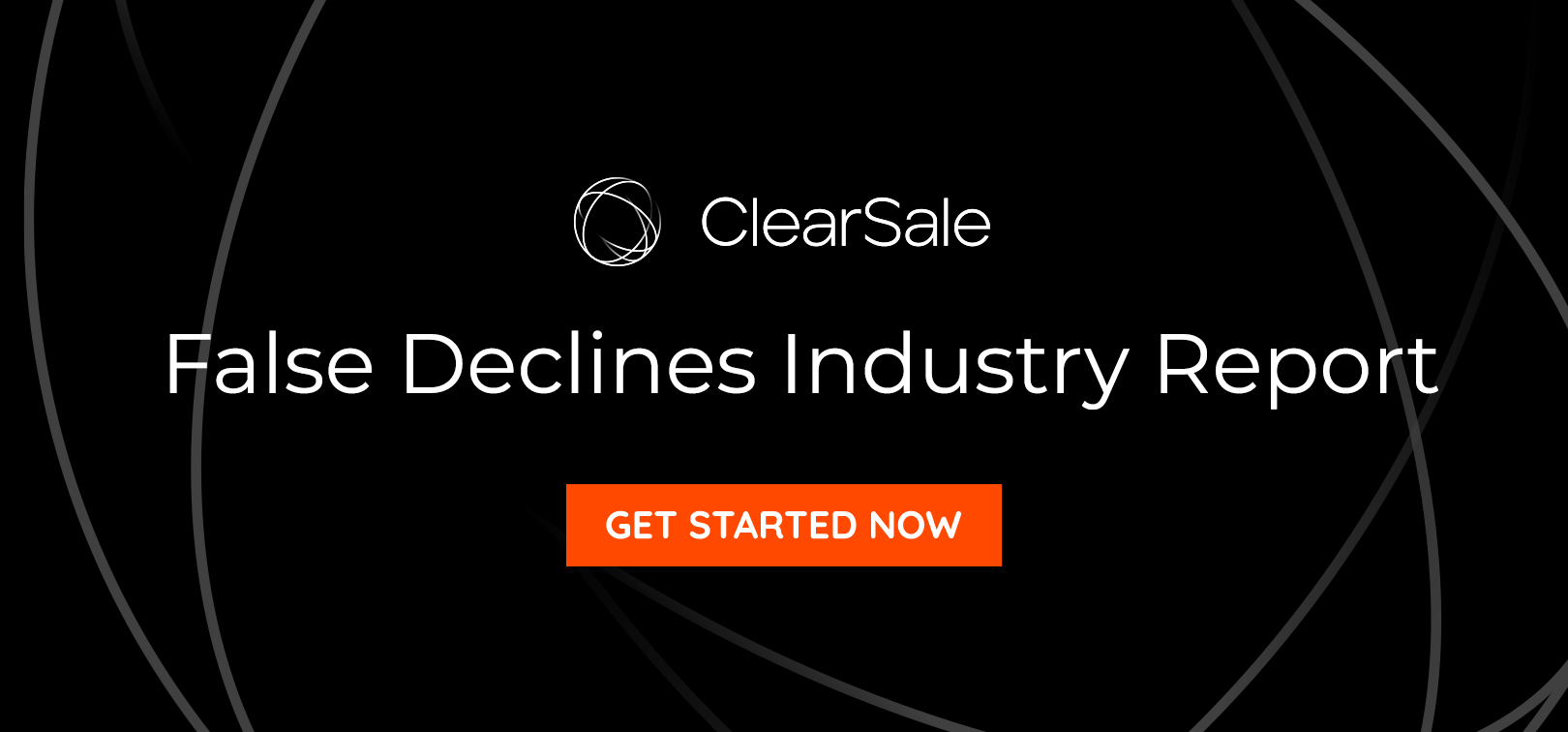Country Profile: The Guide to Ecommerce in Canada
Canada is the logical next step for a U.S.-based ecommerce business looking to expand internationally, or for any ecommerce merchant interested in growing its footprint in North America.
There are few world populations more accustomed to shopping outside of their country’s borders than the people of Canada. The country doesn’t just share the longest land border in the world with the United States. The two nations share relatively similar cultures and a common language.
Canada is an advanced nation with a technologically sophisticated, relatively wealthy population.
However, while Canada has close cultural and economic ties to the U.S., its people have different shopping habits and attitudes, so ecommerce merchants should expect some differences when they venture north.
In this comprehensive guide, we’ll survey the Canadian ecommerce market. We’ll profile the typical Canadian consumer's buying habits and highlight some key opportunities for e-commerce merchants.
We’ll also explore some of the challenges involved with ecommerce in Canada, focusing particularly on the risk of online payment fraud.
Finally, we’ll offer some tips for preventing fraud while selling into the Canadian market.
Canadian Market Overview
By landmass, Canada is the second-largest country in the world. By population (almost 38 million people), Canada is 39th. This combination makes Canada one of the least densely populated countries on the planet.
That fact is somewhat misleading, however, as much of the Canadian population (90% according to one estimate) lives within 100 miles of the southern border with the U.S. That includes the major cities of Toronto and Montreal, both of which are among the 10 most populous cities on the continent.
Internet and Ecommerce Penetration in Canada
As is true in the U.S. and other developed countries, Canada has become an online culture. 87% of the population – nearly 30 million people – are internet users. 81.2% of the population uses a mobile device to go online. And by 2025, 77.6% of Canadians are expected to buy goods and services online.
However, they're not buying everything online. When it comes to small-ticket items (less than $200) Canadians over the age of 45 prefer to shop in-store, presenting challenges for ecommerce businesses targeting Gen X or baby boomers, especially in smaller-purchase markets like health and beauty or pet supplies.
Ecommerce Growth in Canada
The ecommerce market in Canada has been growing steadily for the past half-decade or more, but the COVID-19 pandemic and its resulting stay-at-home orders created an ecommerce explosion:
All of this adds up to a promising ecommerce market, with Canadian ecommerce revenue expected to climb from USD $34.9 billion to $40.3 billion between 2022 and 2025.
How COVID-19 Affected the Ecommerce Market in Canada
As late as June 2019, Canada’s ecommerce market was considered “developing.” But in 2020, Canada went into lockdown to arrest the spread of COVID-19. Brick-and-mortar retail shopping came to a halt throughout most of the country, with more consumers than ever before turning to ecommerce.
The result was a massive surge in online sales that one observer called a “digital tipping point” for the country. Online revenue almost doubled between March and May of 2020.
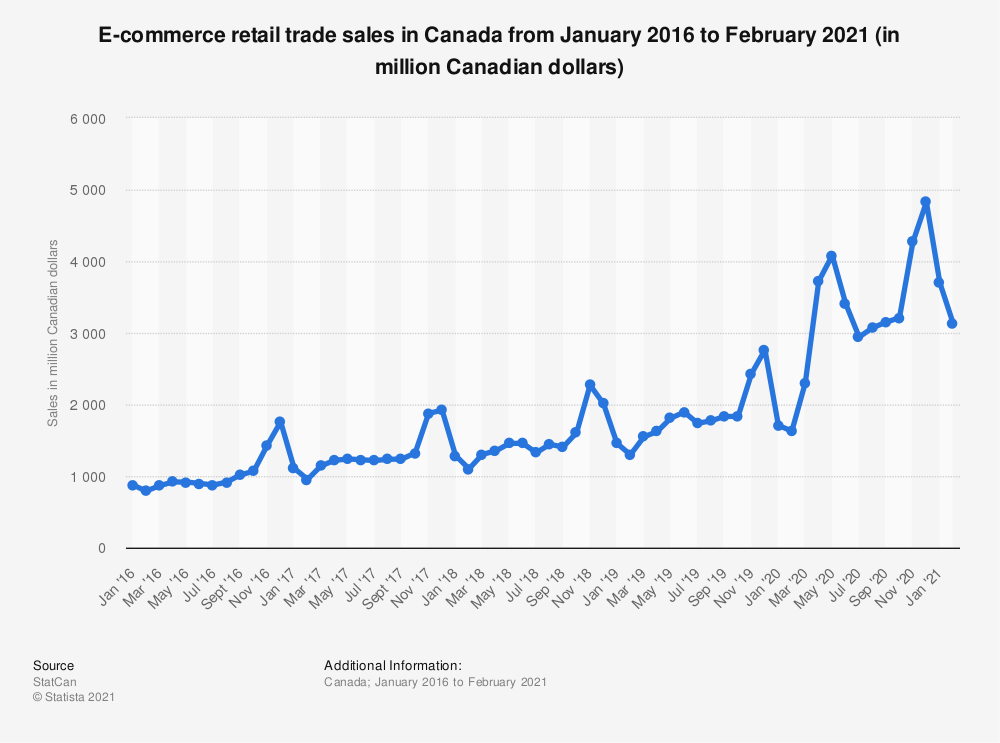
During the coronavirus pandemic, online sales increased in the following categories:
- Sporting goods (+105%)
- Furniture and home décor (+106%)
- Food and restaurants (+160%)
- Appliances, electronics, building materials, and DIY (+161%)
(Year-on-year growth in these categories shows a similar upsurge in online sales.)
Meanwhile, the apparel category grew by a mere 21%, perhaps because that category already saw a significant amount of online sales.
As of June 2021, restrictions across Canada are easing and 64.23% of the population has received at least one dose of a COVID-19 vaccine, with over half of the 80+ population fully vaccinated. As stores open back up and the population feels safer about browsing in stores, ecommerce growth is anticipated to keep growing...but at a considerably slower pace than in 2020.

Ecommerce Shopping Habits and Demographics in Canada
In April 2019, Canada Post surveyed 5,000 ecommerce shoppers in Canada. The results revealed some interesting trends.
- Broken down by age group:
- 37% of Canadian online shoppers are baby boomers (between the ages of 53 and 72).
- 25% are members of Generation X (between 38 and 52).
- 28% are millennials (between 24 and 37).
- The average annual household income for online shoppers in Canada is $102,306 (in Canadian dollars).
- According to the Canada Post survey, online shoppers in Canada are:
- 49% male and 51% female.
- 41% urban, 38% suburban, and 21% rural.
And what of their shopping habits? They've changed.
In 2019, only 10% of people shopped online frequently enough (13 or more purchases a year) to be considered "hyper" shoppers. In 2021, 39% of Canadians shop online on a daily or weekly basis.
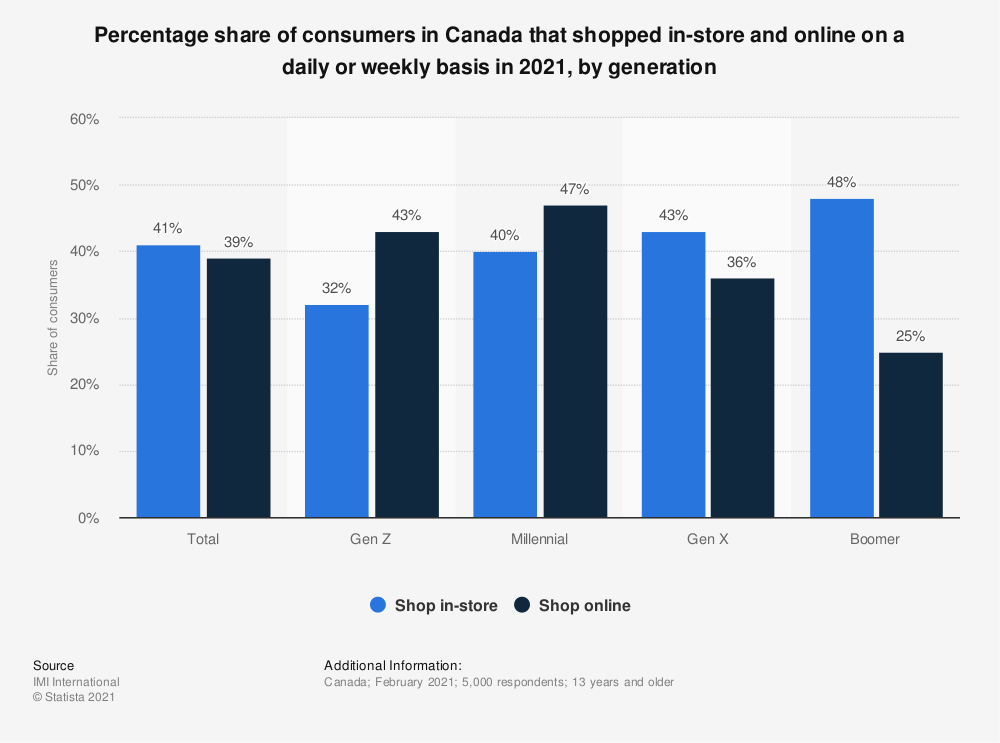
In March 2020, ClearSale commissioned Sapio Research to survey over 1,000 Canadian consumers who shop online at least once every few months. Among other things, the study discovered that:
- 49% of Canadian online shoppers spend less than $65 (U.S. dollars) online per month. 44% spend between $65 and $259 each month. Seven percent spend more than $260 (compared to 20% of Americans).
- The highest number of Canadian consumers say they shop online because of the wider selection. The next most popular reason for shopping online is because it saves time.
What to Consider When Selling in (or into) Canada
With its high internet penetration rate and technology adoption, the benefits of doing business in Canada are similar to the benefits of selling in the U.S. or any other developed country. The customers are online; it is simply a matter of understanding their preferences and shopping habits.
However, while Canadians are online, they tend to stick close to home when it comes to shopping: In 2019, only two of the top 10 online stores in Canada were not Canadian sites.
And in 2020, the pandemic caused many Canadian communities to shop hyper-local, to help save small businesses from the effects of lockdowns. In a 2021 Interac Corp. survey, 75% of Canadians said the pandemic has made shopping and supporting businesses in their community more important, and are even willing to wait longer for delivery and pay higher prices to support local businesses.
If you're not in Canada, however, don't lose hope: There are still plenty of Canadians who love a good cross-border deal, to the tune of $1.6 billion spent on online purchases from foreign companies during the second and third quarters of 2020 combined.
Another consideration when selling into Canada is payment methods. Credit card penetration is high in Canada, with credit cards used for 62% of all ecommerce transactions, but alternative methods like digital wallets are rapidly growing in popularity.
The Challenges of Ecommerce in Canada
As we noted above, merchants can't expect to directly transpose their e-commerce operations from the U.S. or other markets to Canada. Selling profitably in Canada requires overcoming some unique challenges, such as:
Competition with Amazon
As have consumers in the U.S., Canadians have fallen hard for the ease, selection, and low cost of shopping on Amazon sites. Amazon.ca is the most popular online store in Canada by a wide margin.
Interestingly, Amazon competes with itself in Canada. Amazon.com (the company’s U.S.-based site) is the fourth-most popular online shopping destination for Canadian consumers.
Internet Shopping and Research Habits
As Canadians wade further into the waters of ecommerce, they like to do their research before taking the plunge: 55% read several product reviews before making a purchase. If your ecommerce site doesn't have user reviews (and ideally, user-submitted product photos), you'll struggle to gain trust with this market.
The Impact of COVID-19 on Spending
Canadians are buying more online due to COVID-19, but overall, they are spending less on retail shopping. Compared to the same quarter in 2019, Q4 2020 saw a 5% drop in household expenditures.
However, with vaccination rates skyrocketing and regions opening back up to relatively normal activities, consumer optimism has increased: The Bank of Canada says household spending will increase in coming months, potentially leading to a spending boom.
Language Considerations
Canada has a multilingual culture and two official languages: English and French. Over 86% of the population knows enough English to participate in a conversation. Nearly 12% of the population has a working knowledge of French.
However, half of the residents of Quebec (Canada’s second-most populous province) speak French only. French is the only official language in Quebec. There is also a significant population of French-only speakers in New Brunswick (8.6% of provincial residents).
Ecommerce merchants wishing to reach customers in Quebec should be prepared to launch French-language online storefronts and apps.
However, keep in mind that French is a highly regionalized language. The French spoken in Quebec diverges in many significant ways from the French spoken in France. (Canadian English also has a few differences from American English.)
Taxes
Taxes in Canada differ based on the province. All provinces are subject to the national Goods and Services sales tax rate of 7%. In most provinces, this is combined with a Provincial Sales Tax (PST), ranging from 5% to 9%, to create a total Harmonized Sales Tax (HST) rate.
Logistics
Canadians LOVE free delivery (86% of online shoppers will shop more often with a retailer offering free shipping), and most merchants oblige—if they don't, 67% of Canadians will abandon cart.
However, in a country as large as Canada, getting purchases to consumers quickly and affordably isn’t always easy, especially in more sparsely populated or remote areas.
Ecommerce Fraud in Canada
The explosive growth in e-commerce activity in Canada we discussed earlier will undoubtedly be accompanied by a similar increase in ecommerce fraud. Part of the reason for this is Canadians' own risky behavior: A 2021 Moneris/Leger survey revealed that nearly a quarter of Canadians have provided their credit card number over the phone to a store or restaurant—a high risk activity for both the consumers and the businesses. As more Canadians focus on shopping local, this type of behavior is likely to increase.
Consumer Attitudes About CNP Fraud in Canada
Compared to 13% of Americans, 26% of Canadians say online shopping is somewhat or much less safe than brick-and-mortar retail (according to our survey).
This level of caution may reflect the slower rates at which Canadians have adopted online shopping. Still, it underscores the need for any business entering Canadian ecommerce to provide an overtly safe and secure experience.
Canadians, in general, appreciate fraud prevention efforts. 77% of survey respondents told Sapio Research they would be more likely to shop online from vendors that offer fraud protection. 
How to Prevent Fraud When Selling into Canada
When CNP fraud occurs, merchants (in Canada and everywhere else) are typically subject to chargebacks.
A chargeback is initiated when a cardholder notices an unauthorized payment on their account. The cardholder will notify their card-issuing bank. If the bank determines the claim is legitimate, the bank will refund the payment and debit the merchant – usually with an additional fee.
Chargeback fees can range from $50 to $100 or more per transaction. The more chargebacks a merchant incurs, the higher their fees will be. In some cases, banks will remove a merchant’s ability to accept credit card payments entirely.
To prevent chargebacks and other fraud-related damages – such as harm to their reputation – e-commerce merchants doing business in Canada have four basic options for fraud protection:
1. Fraud Filters
Fraud filters are provided by ecommerce platforms and are designed to identify potentially fraudulent orders and stop them from being processed.
Fraud filters can function a number of ways, such as by:
- Limiting how many sales can be submitted to a website during a given time period.
- Using an address verification service (AVS) to ensure shipping and billing addresses line up.
- Flagging or blocking transactions that occur during specified timeframes.
- Checking for errors with the card verification value (CVV) submitted.
- Flagging high-dollar sales that fall outside the merchant’s typical range.
- Looking for IP address mismatches.
While these common filters can prevent a high amount of fraud, they may also stop even more legitimate transactions.
When a fraud prevention measure denies a legitimate transaction, it is called a false decline. We explain the risk of false declines in Canada below.
2. Manual Review
An alternative to automatic fraud filters is manual review, which is just what it sounds like: a team of individuals reviewing each transaction (or a selection of transactions) to detect fraud.
Human fraud experts tend to be better than machines at understanding context. Trained fraud experts can look at each situation individually instead of blindly adhering to preset rules.
However, manual review is very time-consuming and resource intensive. A drawn-out manual review process can annoy customers who are eager to complete their orders.
3. Machine Learning/Artificial Intelligence
Software that relies on machine learning or artificial intelligence (AI) can provide a fast and reliable way to screen out fraud. These applications rely on mathematical algorithms and data to identify fraud trends and patterns. Because no humans are involved, machine learning is scalable and consistent, applying the same level of scrutiny to every transaction.
Unfortunately, like “unintelligent” fraud filters, machine learning can be inflexible. Algorithms can also miss new types of fraud that haven’t yet made it into the algorithm’s database.
4. Fraud Managed Services
Fraud managed services is a “best of all worlds” approach that combines cutting-edge automated technology (including advanced fraud filters and machine learning) with expert manual analysis.
At no point is an order automatically declined. Instead, when the automated system flags an order, the order is passed on to the team of experts who use their knowledge of human behavior and the latest fraud trends to make a final call. The human analysts can flag new trends for insertion into the AI’s algorithm, thereby helping the machine learn faster.
The Risk of False Declines in Canada
False declines are a risk anywhere merchants use automated fraud-protection rules. In fact, false declines can be much more costly to businesses than fraud – up to 13 times as much. This is largely because false declines tend to drive customers away from shopping sites, into the hands of competitors, sometimes never to return.
In high-risk industries, merchants may tighten up their fraud rules, only to lose even more money to false declines.
In our survey of 1,000+ Canadian online shoppers:
- 38% of respondents said that they would never order from that merchant again if a merchant declined their payment (compared to 33% of Americans, who appear to be slightly more forgiving.)

- 25% said that would likely post a negative comment on social media after having a transaction denied by a merchant.
- 46% said they would not even try one more time if a merchant declined their payment. Instead, they would move on to another merchant.
While Canadian consumers are wary of fraud and dislike false declines, they still expect a smooth and easy checkout process.
- 81% of Canadians said they would not proceed with a purchase if they were asked to send copies of documents to confirm an order.
- 60% said they would not proceed with an order if they were asked to call customer service to confirm.
- 40% of Canadians said they have abandoned a purchase online because of a checkout process that was too long or too complicated.
What Fraud Analysts Look for in Canada
In markets like Canada, fraud analysts typically see the same fraud trends over and over again.
The fraud experts at ClearSale tell us that account takeovers – the unauthorized use of someone else’s personal information online – appear to represent most of the e-commerce fraud in Canada. Typical indications of an account takeover include the use of anonymous proxy servers and mismatches between the country and area of the IP address and the billing address.
Fraud analysts also keep their eyes out for high-risk email addresses and high-velocity patterns between transactions.
Our analysts report a clear increase in cases of “friendly fraud” in Canada. Friendly fraud occurs when the customer makes an online purchase with their own credit card and then requests a chargeback from the bank or financial institution after receiving the item or service in question.
Another trend our analysts have noticed in Canada (and now spreading to the United States) is companies experiencing extremely high volumes of suspicious transactions under the same billing customer but with different receivers and shipping information. In some markets, cases like these might be seen as clear fraud, but they may also indicate authentic resellers.
These are the kinds of cases in which human observation and active analysis of the different variables and the visualization of patterns is necessary. Otherwise, many of these legitimate transactions could be categorized as fraud attempts.
The Most Effective Fraud Solution for Ecommerce in Canada: ClearSale
To be successful in the Canadian market, merchants need a fraud prevention solution that stays one step ahead of the most sophisticated fraudsters while eliminating false declines and giving customers a seamless shopping experience.
ClearSale does just that.
At ClearSale, our fraud managed services solution combines advanced statistical and artificial intelligence technology with the world’s largest team of specialized fraud analysts to deliver a balanced, real-world approach that is unlike anything else in the Canadian e-commerce market.
With ClearSale, ecommerce merchants receive:
- Simple ecommerce integration. Our fraud protection solutions quickly integrate with all major ecommerce platforms via an easy-to-install plugin.
- Near-immediate order approvals. Even our human analysts are fast.
- Comprehensive protection against fraud. ClearSale’s Chargeback Insurance program offers 100% guaranteed coverage of all fraud-related chargebacks.
- The highest approval rates in Canada (and anywhere else). Our system will never auto-decline an order.
- An innovative approach. Our multitiered team approach to fraud prevention lets us continually calibrate our proprietary statistical model as new fraud patterns emerge.
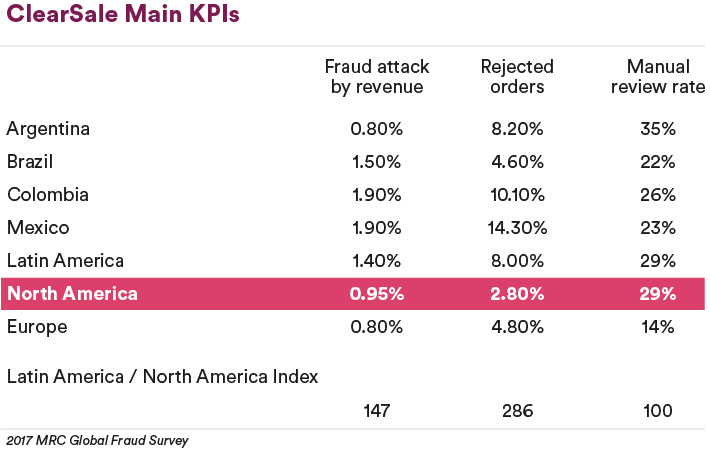
With our headquarters nearby in Latin America, ClearSale knows the Canadian market. If you’re thinking about expanding the reach of your ecommerce business into Canada, get in touch with us today to talk about keeping your business, your reputation, and your customers safe from fraud.
 Sarah Elizabeth
Sarah Elizabeth
